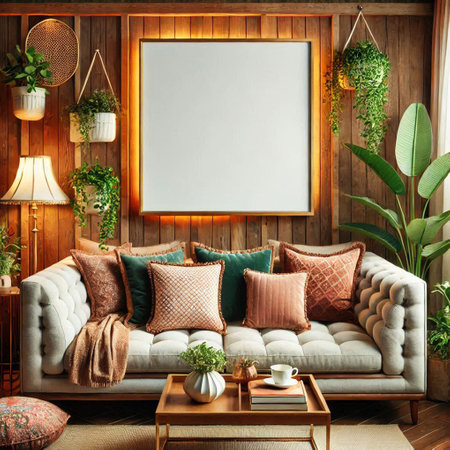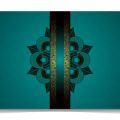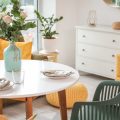Introduction to Mirrored Furniture in Contemporary British Homes
Mirrored furniture has seen a remarkable resurgence across the UK, blending both heritage charm and modern sophistication in British homes. Once considered a decadent feature of Art Deco interiors, mirrored pieces are now celebrated for their unique ability to merge style with practical storage. In today’s British households—where space is often at a premium—mirrored furniture offers an ingenious solution: it amplifies natural light, visually expands rooms, and provides discreet storage options that keep clutter at bay. This revival isn’t just about aesthetics; it reflects evolving lifestyle needs, where form and function must go hand in hand. From chic London flats to cosy countryside cottages, mirrored furnishings have become a staple for those seeking to balance tradition with contemporary living. Their reflective surfaces echo the dynamic tastes of modern Britons while honouring the nation’s longstanding appreciation for craftsmanship and innovation.
Reflecting Light and Maximising Space: The Practical Edge
Urban living in the UK is often synonymous with compact flats and terraced houses, where every square foot counts. Mirrored furniture offers an ingenious solution to these spatial challenges, serving a dual function that goes beyond mere aesthetics. By reflecting both natural and artificial light, mirrored surfaces instantly brighten up even the most modest of rooms—a welcome benefit during Britain’s famously overcast days. This enhancement of brightness not only fosters a more uplifting atmosphere but also creates a perception of depth, giving interiors an airier, more expansive feel.
Maximising space is not just about storage; it’s also about how a room feels and flows. Mirrored sideboards, wardrobes, and coffee tables seamlessly integrate into interiors, visually doubling the size of hallways or lounges without adding physical bulk. Below is a simple comparison highlighting how mirrored furniture stacks up against traditional pieces when it comes to enhancing small spaces:
| Feature | Traditional Furniture | Mirrored Furniture |
|---|---|---|
| Light Reflection | Minimal | High—amplifies both daylight and lamplight |
| Space Perception | No change | Makes rooms appear larger and less cluttered |
| Integration with Decor | Can dominate or darken a space | Blends effortlessly with various styles |
For city dwellers from London to Manchester, where maximising every inch is essential, mirrored furniture becomes more than a style statement—it’s a practical ally. Whether positioned opposite a window to multiply sunlight or used as clever hallway storage that doesn’t crowd the entryway, these reflective pieces help create homes that feel generous, bright, and distinctly modern—all while retaining that quintessentially British sense of understated elegance.
![]()
3. Form Meets Function: Storage with Style
Mirrored furniture occupies a unique space within the realm of interior design, seamlessly marrying visual splendour with genuine practicality. Its dual-purpose appeal is especially apparent in classic British homes, where every inch must work hard to balance elegance and function. Consider the mirrored sideboard—an understated hero in the dining room or hallway. Not only does it serve as a striking focal point, reflecting ambient light and expanding perceived space, but it also provides invaluable storage for tableware, linens, or even those odds and ends that so often clutter our living spaces.
Equally, mirrored bedside cabinets bring a touch of glamour to bedrooms while remaining thoroughly pragmatic. Their reflective surfaces lend a sense of brightness and openness, perfect for smaller UK bedrooms where maximising light is key. Yet beneath the sheen lies ample drawer space for books, night-time essentials, or cherished keepsakes. This clever blend of form and function typifies the British approach to home décor: beautiful yet unpretentious, designed to enhance daily life without sacrificing style.
From compact dressing tables that double as statement pieces to mirrored wardrobes that cleverly disguise ample hanging space, these furnishings encapsulate what it means to live stylishly without compromise. Mirrored furniture proves that you need not choose between aesthetics and utility—each piece offers both, making them an inspired solution for modern British homes seeking storage with sophistication.
4. Choosing the Right Piece for Your Home
Selecting mirrored furniture that complements British interiors requires a thoughtful approach, blending practicality with an appreciation for local design sensibilities. Whether your home boasts Victorian cornices, is nestled within a compact London flat, or supports the hustle and bustle of family life in a suburban semi, the right mirrored piece can both reflect your style and enhance functionality.
Reflecting Period Features
For homes rich in heritage—think Edwardian bay windows or Georgian fireplaces—mirrored furniture with ornate detailing or antiqued finishes will harmonise beautifully. Opt for pieces with bevelled edges or subtle gilding to echo historical charm while introducing contemporary flair.
Maximising Small Spaces
British city living often means making the most of limited square footage. Mirrored furniture naturally amplifies light and creates an illusion of space, making it ideal for small flats. Consider slimline mirrored sideboards or tallboys that offer storage without overwhelming the room.
| Furniture Type | Best For | Key Benefits |
|---|---|---|
| Mirrored Console Table | Narrow hallways, entryways | Adds light, offers surface for essentials |
| Mirrored Wardrobe | Bedrooms in period homes or new builds | Expands sense of space, practical storage |
| Mirrored Coffee Table | Lounge areas in family homes | Creates focal point, easy to clean surfaces |
| Mirrored Bedside Cabinet | Small bedrooms, guest rooms | Compact storage, brightens dark corners |
Versatility for Modern Family Living
If your household juggles multiple needs—from work-from-home setups to children’s play spaces—mirrored furniture can adapt seamlessly. Look for robust designs with wipe-clean surfaces and soft-close drawers. Multifunctional mirrored dressers or shoe cabinets blend style with everyday convenience.
Tapping into Current British Décor Trends
The latest UK interiors embrace a mix of old and new: pairing modern mirrored pieces with traditional elements like herringbone floors or botanical wallpapers creates a layered look. Don’t be afraid to mix textures; a mirrored cabinet alongside velvet upholstery or rustic wood adds depth and intrigue.
Practical Tips for Selection:
- Measure carefully—consider both width and clearance space around doors.
- Select finishes that match existing fixtures (e.g., chrome handles with modern hardware).
- If renting, choose lightweight items that are easy to move without damaging walls.
- Ponder safety—rounded edges are best for families with young children.
With the right choices, mirrored furniture not only elevates your home’s aesthetic but also responds brilliantly to the unique demands of British living spaces.
5. Care, Maintenance, and Longevity
Mirrored furniture brings an undeniable touch of glamour to British homes, but its reflective surfaces require a thoughtful approach to care in our unique climate. Daily life in the UK—with its frequent drizzles, central heating, and urban dust—means that mirrored pieces can easily lose their pristine appeal if neglected. To help you preserve both the beauty and functionality of your mirrored storage, consider these practical tips tailored for British households.
Combatting Dust and Smudges
The typical British home, especially in bustling cities or near busy roads, accumulates a fair share of dust. To prevent this from dulling your mirrored finishes, make it a habit to gently wipe surfaces with a soft microfibre cloth at least twice a week. For stubborn fingerprints or smears, particularly common on high-touch drawers or wardrobe doors, lightly mist the cloth with a solution of distilled water and white vinegar before wiping—avoid spraying directly onto the mirror to protect any wooden trims or backing.
Protecting Against Damp and Condensation
Given the UK’s often damp conditions, moisture can be a real concern for mirrored furniture, especially in rooms like bathrooms or bedrooms with poor ventilation. Always place mirrored pieces away from direct sources of condensation—such as windows prone to fogging or radiators that create temperature fluctuations. If possible, use dehumidifiers or regularly air out rooms to reduce humidity levels. For added protection, check edges and joints periodically for signs of moisture ingress or peeling; addressing these early prevents long-term damage.
Preserving the Finish and Preventing Wear
To keep mirrored furniture looking timeless, avoid placing heavy objects directly on top of mirrored surfaces. Use coasters under drinks and felt pads beneath decorative items to prevent scratches. In family homes where play and movement are constant, position mirrored pieces away from busy walkways to reduce accidental knocks. Regularly check hardware—such as handles and hinges—for tightness; loose fittings can cause misalignment and undue stress on glass panels.
By integrating these simple yet effective maintenance habits into your cleaning routine, you’ll ensure that your mirrored storage remains both stylish and serviceable for years to come—resisting the wear and tear that comes with everyday British living.
6. Current Trends and Local Inspirations
Mirrored furniture has carved out a prominent niche in the UK’s ever-evolving interiors scene, with contemporary trends reflecting both practicality and a distinctive British flair. High-street retailers such as John Lewis, Marks & Spencer, and Next Home have made mirrored side tables, chests of drawers, and wardrobes accessible for those seeking sleek yet functional solutions. These pieces often feature clean lines and understated metallic trims, making them versatile enough for both modern apartments in London and period homes in the Cotswolds.
Meanwhile, boutique makers infuse personality and craftsmanship into their mirrored offerings. Local artisans across the UK are experimenting with antique finishes, bevelled edges, and art deco-inspired patterns—echoing the glamour of 1930s Mayfair or Brighton’s regency revival. These bespoke creations are particularly popular among homeowners who appreciate a touch of heritage or want to support homegrown talent.
Local inspiration is also drawn from Britain’s unique blend of tradition and innovation. Upcycled vintage mirrors transformed into coffee tables or dressing units pay homage to sustainability—a value close to many British hearts. Additionally, mirrored furniture is often paired with rich textiles like tweed or velvet and classic paint colours (think Farrow & Ball’s muted palette), resulting in rooms that feel simultaneously fresh and rooted in place.
The use of mirrored furniture in small UK spaces—such as terraced homes or urban flats—remains on trend, with clever storage options designed to maximise light and create an illusion of openness. As British tastes continue to evolve, expect to see more daring combinations: smoked glass panels, geometric shapes inspired by local architecture, and collaborations between emerging designers and established brands.
Whether you’re drawn to the accessible elegance found on the high street or the one-of-a-kind charm crafted by local makers, mirrored furniture remains a stylish solution that reflects both current trends and Britain’s enduring sense of individuality.


